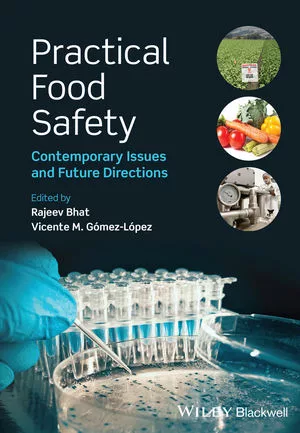Q&A with FDA's New Deputy Commissioner Dr. Stephen Ostroff

Today, the U.S. Food and Drug Administration (FDA) published a question and answer interview conducted with the agency's new Deputy Commissioner, Dr. Stephen Ostroff. Below are snippets from his commentary in relation to food safety the agency's upcoming plans.
Q: What are your goals for the FVM program?
The primary goal is embodied in our public health mission: to ensure that Americans have access to the safest and most healthful food supply possible. To accomplish that, we must have a robust program to promote the safety of the food supply through full implementation of the FDA Food Safety Modernization Act (FSMA). It also means we must have a strong program to address nutrition issues related to diet.
Accomplishing this goal also means that we base our decisions on the best available scientific information. Something I’ve observed repeatedly as chief scientist and as acting commissioner is that when the science is strong, it is much easier to reach consensus and to make sound regulatory decisions.
Q: Now that the FSMA rules are final, why are you still looking for input from stakeholders?
This is a very complex and game-changing law and developing implementing regulations was a very difficult and time consuming task. The regulations are not easy to understand, so there is a tremendous education and training need ahead of us.
There’s no guarantee that we dotted all the “i”s and crossed all the “t”s exactly right as we finalized these regulations, despite all of the feedback through stakeholder engagement sessions and the public comments that we received. It also took several years to develop the regulations. But that work was very beneficial to improve the regulations, but that doesn’t mean that they’re perfect. As we move forward into the implementation phase, we really do need to hear from stakeholders on what aspects of the regulations are working as anticipated and if there are aspects that are not working as we envisioned. Only then can we maximize the public health benefits anticipated from FSMA. So we will continue to be in listening mode.
Q: How do you see FVM’s approach to foodborne illness outbreaks?
One of the fundamental principles of FSMA is to try to move the food safety system to a more preventive posture from a posture that largely reacts to problems once they’re recognized, usually in the form of outbreaks of foodborne illness. That’s the ideal, but no one should be under the illusion that once FSMA is fully implemented food safety problems will completely disappear. We have to remain vigilant and we must respond as rapidly as possible.
We’re working to put tools in place to be able to do that, and we will be working in partnership with CDC and with partners at the local, state and international levels. We will also partner with regulated industry to support compliance and to recognize and correct problems.
One of the best tools we’ll be using more frequently is whole genome sequencing (WGS), a scientific tool that is something of a game changer in how rapidly it enables us to identify an outbreak and find the source. There will also be enhanced methods to monitor FSMA compliance. So there’s going to be a lot more data available for us to potentially spot problems and link them to their source. This will help us recognize outbreaks earlier and prevent them from growing, and to find outbreaks that we previously would not have been able to see.
Q: What nutrition issues are priorities for you?
Sodium reduction is very important. We’ve issued draft voluntary targets for reducing sodium in commercially processed and prepared food both in the short-term (two years) and over the long-term (10 years). American diets contain too much sodium, and too much sodium can lead to high blood pressure, a major cause of stroke and heart disease. These voluntary targets should help reduce the sodium content of the food supply and make it easier for people to consume less sodium.
Another priority area is the work we are doing in the area of dietary supplements. We recently took steps to enhance our work, including the creation of a separate office and recruiting new leadership. I think this will allow us to better work with and oversee the dietary supplements industry, which is rapidly growing and changing, and to be able to better use the regulatory tools that we already have at our disposal.
I’m also very excited that we recently finalized the revisions to the Nutrition Facts label, which will provide consumers with updated information about the items they purchase in order to make the most informed food choices.
Q: You’ve been to China, Mexico and Canada in recent months. How important do you see our collaborations with foreign food producers and regulators?
We work in a global food system. We’re a major importer, and we’re a major exporter trading with many countries. It’s been estimated our food comes from 200 different countries. So we’re not an isolated country when it comes to our food supply. To successfully regulate in such a globalized system requires strong partnerships with our overseas regulatory partners. In addition, FSMA requires that we work with our regulatory partners to be able to help implement a central concept of FSMA, namely to assure that foods produced overseas are as safe as foods produced in the United States.
An important tool in our work with other countries includes systems recognition. The first systems recognition arrangement was signed with New Zealand in 2012. We recently signed an arrangement with Canada, and there are a number of other countries we’re looking to partner with in this way. With such arrangements, we can say with confidence that, while another country’s other food safety system may not be identical to ours, at the end of the day it provides the same level of public health protection. This allows us to take a risk-based approach and better focus those resources we have overseas to locations in which they can have the most impact in protecting American consumers from unsafe food.
Q: What are some of the challenges ahead?
One of the interesting aspects of working at FDA is that the commodity categories we regulate are always changing; they’re growing and there’s a great deal of innovation going on. There’s also increasing globalization of these commodities. We have to be aware of these trends and we have to keep pace with innovation in the industries we regulate not only by having people who understand the science behind these innovations, but also by updating and changing our approaches to how we oversee and regulate them.
Biotechnology is one example of how change is occurring in how foods and veterinary products are produced. We have to have the skill sets in our workforce to adequately evaluate these modern tools that the food and animal health industry is using. You can’t be in a circumstance where the industry and the products of that industry have changed considerably, but we’re still regulating as if they haven’t changed.
And so in areas where there has been tremendous innovation underway, such as food additives, cosmetics, nutritional science or dietary supplements as examples, it’s in our best interest to be constantly reviewing our portfolio of activities and updating them as necessary to provide the most effective oversight in order to achieve the best public health outcomes and to assure consumer confidence in these products.
Q: In closing, why are you so interested in food safety?
Everyone knows the quote “You are what you eat.” We’re all what we eat. At FDA, we touch every American on a daily basis through the foods that they consume. And so I would hope that every American understands what it is that we do and why we do it to protect the food supply.
Looking for quick answers on food safety topics?
Try Ask FSM, our new smart AI search tool.
Ask FSM →








